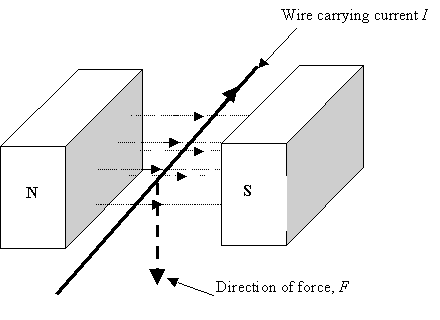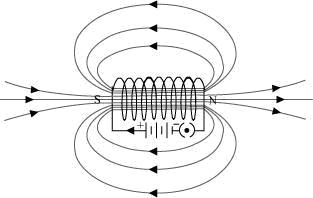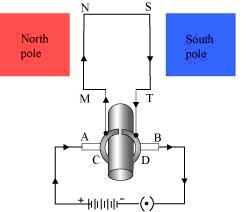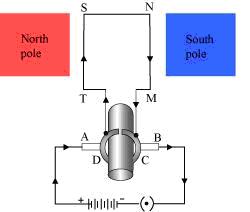CBSE Class 10 Science Notes of Chapter 13 Magnetic Effects of Electric Current, Video Explanation, and Question Answers
Magnetic Effects of Electric Current Class 10 – Here is a CBSE Class 10 Science Chapter 13 Magnetic Effect of Electric Current Notes, and Detailed Explanation.
Topics Covered in this Lesson are Fleming’s left hand rule, magnetic field, electric motor, magnetic field produced by straight conductor, electromagnetic induction, magnetic field produced due to circular loop, fleming’s right hand rule, magnetic field produced due to solenoid, len’z law, strength of a magnetic field can be changed by, ac generator, electromagnet, earthing, kicking wire experiment, and NCERT Solutions Class 10 Science Chapter 13.
Class 10 Science Chapter 13 – Magnetic effects of electric current
- See Video Explanation of Magnetic Effect of Electric Current
- Fleming’s left hand rule
- Magnetic field
- Electric motor
- Magnetic field produced by straight conductor
- Electromagnetic induction
- Magnetic field produced due to circular loop
- Fleming’s right hand rule
- Magnetic field produced due to a solenoid
- Lenz’s law
- Strength of a magnetic field can be changed by
- Ac generator
- Electromagnet
- Earthing
- Kicking wire experiment
- NCERT solved exercises
Magnetic Effect of Electric Current Class 10 Video Explanation
Magnetic Effects of Electric Current Related Links –
Introduction – What is the Magnetic Effect of Electric Current
What is the Magnetic Effect of Electric Current – As we have already studied electricity and its effects you will be surprised to know that the magnetic effect and heating effect are after-effects of current?
In this chapter, we are going to focus on the magnetism produced due to electricity and also electricity produced due to magnetism. So let us study about magnets and their properties.
At first, the magnetic concept came in to notice when it was observed that in the center of the earth i.e. the core, there is a substance that can attract certain substances towards itself and that substance is regarded as a natural magnet called a lodestone. Considering the properties of the natural magnet, the man-made magnets were developed. So let us define magnet first.
Related – Tips to score 95% in Class 10 Science Paper

Magnet: It is an object which attracts pieces of iron, steel, etc. towards itself.
Man made magnets are of different shapes like
-
- Bar magnet- a long rectangular piece of magnet
- Horseshoe shaped- U shaped magnet

- Magnetic needle


- Magnetic compass
Some facts about magnets:-
- When a magnet is freely suspended, it always aligns towards north-south direction.

- Like poles always repel & opposite poles attract each other.

- Magnet always exists as dipole

- Two poles can never be separated: if we try to cut them then also, both the poles will exist even in a small piece of magnet. It automatically develops the lost polarity.

- A magnet always develops certain area around it where its effect can be felt i.e. magnetic field.
Magnetic field
It is studied by drawing imaginary lines called magnetic lines of forces.

Characteristics of Magnetic Field:
- They always originate from north pole & terminate at the south pole. This shows that if the north pole was free, it would have moved towards the south pole.
- The place where they are closer indicates a strong magnetic field i.e. at the poles.
- Magnetic Field lines give the direction of magnetic force.
- Two magnetic lines will never intersect each other as they give direction of force & force can not have 2 directions at a time.
- Magnetic Field lines are closed continuous curves.

Magnetic lines produced around bar magnet :
Oersted’s experiment :-
He conducted an experiment and proved that a wire carrying an electric current produces a magnetic field around it. The direction of magnetic field was confirmed by the deflection of magnetic needle kept near the current carrying conductor or we can say near the circuit.
The rules that are given are listed below :

Ampere swimming rule: Suppose a person is swimming in the direction of current such that current enters the man through his feet and leaves his body through his head, then the magnetic needle kept below it will get deflected towards it.

Snow rule: According to this rule, when the current flows from the south to the north, the needle deflects towards the west.
Top
Class 10 Science Chapters
Magnetic field produced by straight conductor
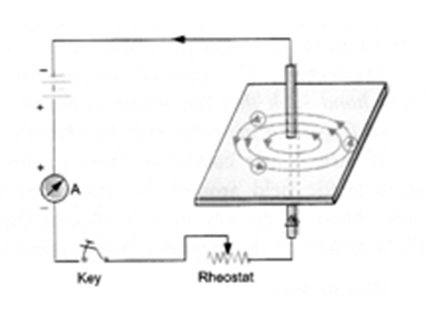
Characteristics:
(a) Magnetic lines are concentric circles.
(b) The direction of magnetic lines reverses as we reverse the direction of the current.
When current flows upward, the direction of magnetic lines is anticlockwise.
When current flows downward, the direction of magnetic lines is clockwise.
(c) The Magnetic field produced is directly proportional to the current & inversely proportional to the distance from the conductor.
(d) To know the direction of magnetic field around a straight conductor, we have different sets of rules as given below:
- Right hand thumb rule: Suppose you grasp the conductor in your right hand such that the thumb points in the direction of the current, then the direction in which your fingers curl gives the direction of the magnetic field.
Magnetic field produced due to circular loop
The Magnetic field produced around a circular loop is also circular. As we move away from the loop, the concentric circle becomes bigger. At the centre, the magnetic lines are parallel.

Characteristics
-
- The magnetic lines are circular at the points from where the current enters or leaves the coil.
- Within the space enclosed by the coil, the field lines are in the same direction.
- Near the centre of the coil, the magnetic lines are almost parallel to each other.
- At the centre of the coil, the plane of magnetic field lines is at right angles to the plane of circular coil.
- Magnetic field produced is directly proportional to the current and inversely proportional to the distance from the conductor.
- The part from where the magnetic lines enter the coil facing us is considered as south pole and the other is north pole.
Current flowing clockwise = south
Current flowing anti clockwise = north
The magnetic field produced due to solenoid
Solenoid: It is a long coil containing a large number of turns of copper wire.

When solenoid is connected to a battery and current is passed through it, it also produces a magnetic field which is similar to the magnetic field produced around a bar-magnet i.e., one side of solenoid acts as the north pole & other as the south pole.
Strength of magnetic field can be changed by
-
- Increasing the amount of current.
- Increasing the number of turns of copper wire.
- Decreasing the gap between turns of copper wire.
- The nature of material used in making solenoid.
Electromagnet
It is a substance which starts behaving as a magnet when a current is passed through it but as the current is switched off, magnetism is lost.
- It consists of a long coil of copper wire wound on a soft iron core. The ends of the copper wire are connected to a battery.

Factors affecting the strength of an electromagnet are as follows:
-
- Number of turns in the coil.
- Current flowing in the coil.
- Length of gap between the poles.
Steel is not used for making electromagnet as it does not lose its magnetism even if the current is switched off i.e., it forms a permanent magnet.

On pressing the switch, current flows in the wire in the downward direction as it is placed between the poles of the magnet because force acts on it and wire gets displaced from its original position. As it gets displaced, the circuit breaks and the flow of current stops due to which no force acts on the wire and it returns to its original position. Again, the circuit gets completed, force acts and the wire get displaced. This is how it goes on repeating.
Top
Important Videos Links
Fleming’s left hand rule
Stretch your forefinger, centre finger & thumb mutually perpendicular to each other such that the fore finger points in the direction of the magnetic field. The centre finger indicates the direction of current & thumb gives the direction opf the force of motion.
Electric motor
It is a device which converts electrical energy into mechanical energy.

Principle- When a rectangular coil carrying current is placed in a magnetic field, it experiences a force that rotates it.
B1 & B2 – Brushes.
Function: To make contact with split rings. Split Rings Commutator formed by splitting of copper ring. Its function is to reverse the direction of the current.
Working of Electric Motor
Imagine a coil ABCD is in a horizontal plane such that magnetic field is parallel to the plane of the coil. When electric current is passed through coil
A and B
- In segment AB current flows from A to B. Applying Fleming’s left hand rule, we come to know that it experiences force in upward direction C and D.
- In segment CD, current flows from C to D and force acts downwards (By fleming’s left hand rule).
- The two forces being equal and opposite form a couple and rotate the coil in clockwise direction.
When the coil turns an angle of 90o, commutator loses contact with brushes and thus, no force acts on the coil. But due to the momentum gained, the coil continues rotating till it covers an angle of 180o. After 180o, S1 connects with brush B2 and S2 connects with B1. This alters the direction of current in coil and new current flows in the direction BADC. This is how electric motor’s work.
Electromagnetic induction
The production of electricity from magnetism is called electromagnetic induction.
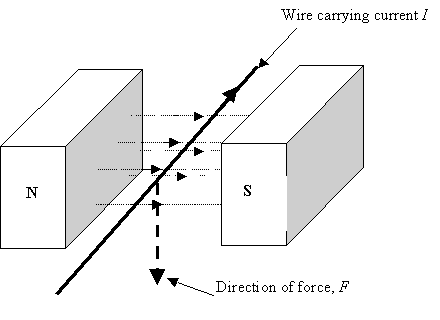
Experiment: Wire AB is held between the poles of a magnet. Two ends of the wire are connected to a galvanometer. Still no current is produced but when the wire is in motion between poles of magnet, it cuts the magnetic lines, due to which the strength of the magnetic field is changed and current is induced in the wire.
It is defined as the production of current in a conductor when the conductor is moved between the poles of the magnet. The current produced is called induced current.
Fleming’s right hand rule
Stretch your forefinger, center finger and thumbs mutually perpendicular to each other such that the forefinger points in the direction of magnetic field. The thumb points in the direction of motion & center finger indicates the direction of induced current.
Lenz’s law
In all the cases of electromagnetic induction, the direction of induced current is such that it always opposes the cause that produces it. For Example: When north pole of magnet is approaching the end A of the coil, then the direction of induced current is such that it opposes the motion of the north pole towards A.
AC generator
It is a device which converts mechanical energy into electric energy.
Principle:- When the conductor is moved in the magnetic field then the current is induced in the conductor.
Working of AC Generator
Imagine that a coil ABCD is in a horizontal position. Now, it is rotated in an anticlockwise direction between poles of magnet by rotating its shaft. When coil rotates, AB of coil moves down, cutting magnetic field lines of north pole and CD moves up, cutting magnetic field lines of south pole. Due to this, induced current is produced. Applying Fleming’s right hand rule,
Direction of current is B to A and D to C i.e. BADC
Current in the external circuit flows from brush B1 to B2
After half rotation, sides AB and CD will interchange their position, so, AB starts moving up and CD moves down. Induced current is produced.
Direction of current
C to D and A to B i.e. CDAB
External circuit current flows from B2 to B1.
Earthing
Electrical appliances are always touched by hands. There can be a chance that the insulation breaks or cracks and the bare wire touches the metal case and then the person touching them might get a shock. To avoid such incidents, the metal cases are earthed. By earthing we mean that the metallic body is connected to a thick copper wire which is buried deep under the earth. And at the end, the copper plate is surrounded by a mixture of charcoal and common salt.

The earth is always at 0 potential. So, if an electrical appliance gets short circuit, the current flows to the metal body deep inside the earth. If the magnitude of current rises due to short circuit, the fuse wire melts but the appliance or the user will not receive any current as it is earthen.
Class 10 Science Chapters, Explanation, Notes
| Life Processes | Chemical Reaction and Equation | Acids bases and Salts |
| Periodic Classification of Elements | Metals and Non-Metals |
NCERT Solutions Class 10 Magnetic Effects of Electric Current
1. Which of the following correctly describes the magnetic field near a long straight wire?
(a) The field consists of straight lines perpendicular to the wire.
(b) The field consists of straight lines parallel to the wire.
(c) The field consists of radial lines originating from the wire.
(d) The field consists of concentric circles centred on the wire.
Ans. (d) The field consists of concentric circles centred on the wire.
2. The phenomenon of electromagnetic induction is
(a) the process of charging a body.
(b) the process of generating magnetic field due to a current passing through a coil.
(c) producing induced current in a coil due to relative motion between a magnet and the coil. (d) the process of rotating a coil of an electric motor.
Ans. (c) producing induced current in a coil due to relative motion between a magnet and the coil
3. The device used for producing electric current is called a
(a) generator.
(b) galvanometer.
(c) ammeter.
(d) motor.
Ans. (a) generator.
4. The essential difference between an AC generator and a DC generator is that
(a) AC generator has an electromagnet while a DC generator has permanent magnet.
(b) DC generator will generate a higher voltage.
(c) AC generator will generate a higher voltage.
(d) AC generator has slip rings while the DC generator has a commutator.
Ans. (d) AC generator has slip rings while the DC generator has a commutator.
5. At the time of short circuit, the current in the circuit
(a) reduces substantially.
(b) does not change.
(c) increases heavily.
(d) vary continuously.
Ans. (c) increases heavily
6. State whether the following statements are true or false.
(a) An electric motor converts mechanical energy into electrical energy.
(b) An electric generator works on the principle of electromagnetic induction.
(c) The field at the centre of a long circular coil carrying current will be parallel straight lines.
(d) A wire with a green insulation is usually the live wire of an electric supply.
Ans.
a) False
b) True
c) True
d) False
7. List two methods of producing magnetic fields.
Ans. Two methods of producing magnetic field are as follows:
(a) By using current-carrying conductors
(b) By using permanent magnets
(c) By electromagnets
8. How does a solenoid behave like a magnet? Can you determine the north and south poles of a current–carrying solenoid with the help of a bar magnet? Explain.
Ans. A solenoid is a long coil of circular loops of insulated copper wire. Magnetic field is produced around the solenoid when a current is allowed to flow through it. The magnetic field produced by it is similar to the magnetic field of a bar magnet. The field lines produced in a current-carrying solenoid is shown in the following figure.
In the above figure, when the North pole of a bar magnet is brought near the end connected to the negative terminal of the battery, the solenoid repels the bar magnet. Since like poles repel each other, the end connected to the negative terminal of the battery behaves as the North pole of the solenoid and the other end behaves as the South pole. Hence, one end of the solenoid behaves as a North pole and the other end behaves as a South pole.
9. When is the force experienced by a current–carrying conductor placed in a magnetic field largest?
Ans. The force experienced by a current-carrying conductor is the maximum when the direction of current is perpendicular to the direction of the magnetic field.
10. Imagine that you are sitting in a chamber with your back to one wall. An electron beam, moving horizontally from back wall towards the front wall, is deflected by a strong magnetic field to your right side. What is the direction of magnetic field?
Ans. The direction of magnetic field is given by Fleming’s left hand rule. Magnetic field inside the chamber will be perpendicular to the direction of current (opposite to the direction of electron) and direction of deflection/force i.e., either upward or downward. The direction of current is from the front wall to the back wall because negatively charged electrons are moving from back wall to the front wall. The direction of magnetic force is rightward. Hence, using Fleming’s left hand rule, it can be concluded that the direction of magnetic field inside the chamber is downward.
Related – Take Free Online MCQs Test for Science Chapters
11. Draw a labelled diagram of an electric motor. Explain its principle and working. What is the function of a split ring in an electric motor?
Ans. An electric motor converts electrical energy into mechanical energy. It works on the principle of the magnetic effect of current. A current-carrying coil rotates in a magnetic field. The following figure shows a simple electric motor.
When a current is allowed to flow through the coil MNST by closing the switch, the coil starts rotating clockwise. This happens because an inward force acts on length MN and at the same time, an outward force acts on length ST. As a result, the coil rotates clockwise.
Current in the length MN flows from M to N and the magnetic field acts from left to right, normal to length MN. Therefore, according to Fleming’s left hand rule, an inward force acts on the length MN. Similarly, current in the length ST flows from S to T and the magnetic field acts from left to right, normal to the flow of current. Therefore, an outward force acts on the length ST. These two forces cause the coil to rotate clockwise.
After half a rotation, the position of MN and ST interchange. The half-ring D comes in contact with brush A and half-ring C comes in contact with brush B. Hence, the direction of current in the coil MNST gets reversed.
The current flows through the coil in the direction TSNM. The reversal of current through the coil MNST repeats after each half rotation. As a result, the coil rotates unidirectional. The split rings help to reverse the direction of current in the circuit. These are called the commutator.
12. Name some devices in which electric motors are used.
Ans. Some devices in which electric motors are used are as follows:
(a) Water pumps
(b) Electric fans
(c) Electric mixers
(d) Washing machines
13. A coil of insulated copper wire is connected to a galvanometer. What will happen if a bar magnet is
(i) pushed into the coil,
(ii) withdrawn from inside the coil,
(iii) held stationary inside the coil?
Ans. A current induced in a coil if a bar magnet is moved relative to it. This is the principle of electromagnetic induction.
(i) When a bar magnet is pushed into a coil of insulated copper wire, a current is induced momentarily in the coil. As a result, the needle of the galvanometer deflects momentarily in a particular direction.
(ii) When the bar magnet is withdrawn from inside the coil of insulated copper wire, a current is again induced momentarily in the coil in the opposite direction. As a result, the needle of the galvanometer deflects momentarily in the opposite direction.
(iii) When a bar magnet is held stationary inside the coil, no current will be induced in the coil. Hence, galvanometer will show no deflection.
14. Two circular coils A and B are placed close to each other. If the current in the coil A is changed, will some current be induced in the coil B? Give reason.
Ans. Two circular coils A and B are placed close to each other. When the current in coil A is changed, the magnetic field associated with it also changes. As a result, the magnetic field around coil B also changes. This change in magnetic field lines around coil B induces an electric current in it. This is called electromagnetic induction.
15. State the rule to determine the direction of a
(i) magnetic field produced around a straight conductor-carrying current,
(ii) force experienced by a current-carrying straight conductor placed in a magnetic field which is perpendicular to it, and
(iii) current induced in a coil due to its rotation in a magnetic field.
Ans. (i) Right hand thumb rule
(ii) Fleming’s left hand rule
(iii) Fleming’s right hand rule
16. Explain the underlying principle and working of an electric generator by drawing a labelled diagram. What is the function of brushes?
Ans. An electric generator converts mechanical energy into electrical energy. An electric generator consists of a rotating rectangular coil placed

between the two poles of a permanent magnet.The two rings R1 and R2 are internally attached to an axle. The axle may be mechanically rotated from outside to rotate the coil inside the magnetic field.
Outer ends of the two brushes B1 and B2 are connected to the galvanometer to show the flow of current in the external circuit. When the axle is rotated, arm AB moves up (and the arm CD moves down) in the magnetic field produced by the permanent magnet. Let us say that the coil ABCD is rotated clockwise. By applying Fleming’s right-hand rule, the induced currents are set up in these arms along the directions AB and CD.
Thus, an induced current flows in the direction ABCD. If there are more turns in the coil, the current generated in each turn adds up to give a large current through the coil. After half rotation, CD and AB reverse direction, and thus, CD starts moving up and AB starts moving down. As a result, the direction of the induced currents in both the arms change. Such a current which changes direction after equal intervals of time is called an alternating current.
Thus, this device is called an AC generator. To get a direct current, a split-ring type commutator must be used. The generator is thus called a DC generator. The difference between direct and alternating currents is that the direct current always flows in one direction, whereas the alternating current reverses its direction periodically.
17. When does an electric short circuit occur?
Ans. An electric short circuit occurs when the live wire and the neutral wire come in direct contact. This happens when the plastic insulation of live wire and neutral wire gets torn or when there is a fault in the electrical appliance.
18. What is the function of an earth wire? Why is it necessary to earth metallic appliances?
Ans. The metallic body of electric appliances is connected to the Earth by means of earth wire so that any leakage of electric current is transferred to the ground. This prevents any electric shock to the user. That is why earthing of electrical appliances is necessary.
Class 10 Science Chapter-wise Explanation


